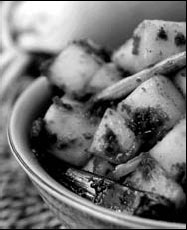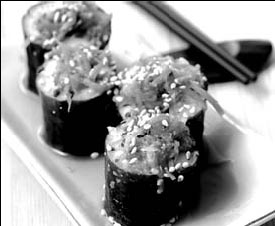Getting in a pickle

Homemade preserves are easy to do and a lot cheaper than buying ready-made at the markets. Pauline D Loh introduces you to their pleasures, Korean-style
Kimchi is about as Korean as the latest K-pop TV serials starring delectable cheesecake and beefcake actors with perfect skin and sexy dimples. And just like those dreamboats, kimchi can also make your smooch-ready lips pucker up.
But unlike unrequited love for a TV actor, developing a fascination for these deliciously tart pickles is good for you. They promote digestion, stimulate the appetite and easily fulfill your quota of fruits and vegetables for the day.
They are also becoming immensely popular as more and more cross-border eateries proliferate in all our major cities. Bulgogi, dulsot, bibimbap and kimchi fried rice are all almost as popular as our native noodles.
Asia is such a vast continent of ethnic diversity and geographical contrast that its many varied cuisines can make a hungry gourmet happy 24/7 for a whole year and more. The cuisines are all rich in flavor and history and every traditional dish tells its own story.
Pickles have a lineage that spans at least three countries and cuts across the culinary heritage of China, Korea and Japan. Their epicurean roots also tell of the migration of people, food and dining customs.
There has been a long, ongoing debate on whether kimchi belongs to Korean or Japanese cuisine. The Chinese, confident that they invented these pickles, have stayed out of the debate, finding it a waste of time to argue on what they already know is the truth.
But you have to admit that the Koreans have the upper hand in successful marketing kimchi as their own.
Kimchi-making is a seasonal activity in any Korean home, made in the depth of winter usually when the cabbages are at the fattest. Tons of cabbages are salted and hoarded in underground urns or special kimchi refrigerators, and carefully brought out and served throughout the year.
In the cooler months, the large white radishes or daikon are also at their best and ready for some spicy pickling.
One of the most popular pickles these days, normally eaten quite fresh, is the cucumber pickle, or kyuri kimchi. The tender green cucumbers are barely marinated a day or two and are enjoyed for their cool, crisp, clean taste.
Kimchi uses a pickling mix that is a prime example of culinary chemistry.
First, there is the starter liquid made of a light glutinous rice soup. The heavy starch in this accelerates the fermenting process that gives kimchi its unique pungency. Then pear or apple is grated or pureed, supplying the light Vitamin C acidity, which keeps the pickles fresh tasting.
Another ingredient is the fermented shrimp paste that is made from brined krill (or the ubiquitous xiapi that the Beijing chef is so fond of.) Just a small spoonful hastens the fermentation process and adds a powerful kick.
The compulsory addition of crushed garlic or chives also fulfills a "medicinal" purpose as both garlic and chives have anti-bacterial properties.
The addition of chili powder, grated radish, grated carrots and ginger add texture, flavor and color to the pickles.
Kimchi is also roughly divided into those that require more maturing in urns or containers and those that are eaten the same day, or at least within the week.
Cabbage pickle, the most familiar version of kimchi, is left to mature for weeks or even months. This has the characteristic "sour" smell and gets tarter as it matures. After a while, the strong flavors turn it from a side-dish into a flavoring agent - and this is when it is used to make kimchi soup, or kimchi fried rice.
There is also marinated kimchi, which does not use glutinous rice paste or shrimp sauce. A good example of this type of kimchi is the cucumber kimchi, which is salted and marinated in a chili and fruit puree mixture. Kept in the fridge and chilled until ready to eat, these cucumber pickles are very refreshing as a side-dish, or eaten with white porridge.
In Beijing, Korean ingredients are easily available in most major supermarkets, including the fermented shrimp paste. And of course, you can always visit the "Korean town" on the way out to the airport, although you may have to hone your second language skills first.
I have gathered some of my own favorite kimchi recipes for you here. They can all be made quite easily at home, and should yield a few containers, which you can keep chilled and enjoy at your leisure.
Recipe | KOREAN CABBAGE KIMCHI
Ingredients:
1 kg Chinese cabbage (about 1 large head)
60g sea salt (or rough salt)
200g white radish, grated
1 small carrot, peeled and grated
1 tbsp sugar
Pickling mix:
1 tbsp honey
2 tbsp glutinous rice water
1 tbsp white sesame seeds, toasted and ground
50g red chili powder
50g fermented shrimp paste
5 cloves garlic, pounded to paste
1/2 apple, grated
Method:
1. Cut cabbage into quarters, separating segments from the root end. Slice off the solid core, but take care not to cut through and cause the leaves to disintegrate.
2. Place cabbage wedges in a deep basin and cover with water mixed with one third of the salt.
3. Weigh down the cabbage by putting a heavy object on top and leave to soak about two to three hours until they turn limp. Drain the cabbage and squeeze dry.
4. Prepare pickling sauce by mixing honey, glutinous rice water, ground sesame seeds, red chili powder, fermented prawn paste, pounded garlic and grated apple. Set aside.
5. Marinate the grated radish and carrots with 1 tablespoon of sugar. Drain the juices after 10 minutes and squeeze dry.
6. Mix carrot and radish into pickling sauce and let sit for an hour for flavors to develop.
7. Spread drained cabbage wedges on a cutting board and open up the leaves. Spread the pickling mixture over and in-between every leaf, taking care not to miss the bases.
8. Roll up each wedge tightly, wrapping the outer leaf around so you get a "ball".
9. Place each cabbage ball into the pickling jar and press down to express all trapped air. Place a heavy stone or brick on top to keep cabbage firmly down.
10. Leave to pickle for up to four days to a week in a cool, dry place.
11. Open up pickling jar and check for ripeness. If you smell the characteristic kimchi aroma, it's ready and should be transferred to tightly sealed containers in the fridge.
12. Cabbage kimchi made this way keeps up to two weeks in the fridge.
Food Notes:
Salting the cabbage starts a dehydration process that keeps the vegetable crisp even after pickling. Fermented shrimp paste may seem an unlikely ingredient, but it helps kick-start the fermenting process and adds to the characteristic kimchi pungency.
Use a large glass jar with a wide mouth so you can visually check the fermenting progress. Traditional earthenware pickling jars have a depressed rim so the cover inverts snugly into a ring of water that prevents air from entering.
If you cannot find a stone or brick to weigh the cabbages down, put well-scrubbed large pebbles into a bag and use that as a weight.
In hot regions where indoor temperatures are high, kimchi should not be left to pickle more than two or three days or it will become too sour.
Recipe | DAIKON (white radish) KIMCHI

Ingredients:
1 white radish (about 1 kg)
1 stalk spring onion
1 tbsp fermented shrimp paste
1 tsp sea salt
1 tbsp sugar
2 tbsp chili powder
2 cloves garlic, pounded to paste
2 cm piece ginger, pounded to paste
Method:
1. Peel the radish and cut into 2-cm cubes. Sprinkle with salt and toss to mix. Place in colander to allow juices to drain. Rinse quickly and squeeze dry.
2. Place radish cubes in a bowl and toss with sugar. Add chili powder, ginger and garlic paste and spring onion stalks. Mix well.
3. Marinate overnight before eating. It can be kept chilled in the fridge for up to one week.
Food Notes:
You need to cut the radish into largish cubes, as they will shrink during the pickling process. This is an "every day" kimchi recipe that does not need a long pickling process. It is simple to do and the radishes keep crisp for up to a week, well chilled. Do not make large quantities as this is best eaten fresh for the fullest flavor and crispiest texture.
Recipe | KYURI (cucumber) KIMCHI

Ingredients:
3 kyuri or green cucumbers
20g sea salt (or rough salt)
3 tbsp grated radish
4 tbsp grated carrot
1 2-cm piece ginger
1 tsp sugar
1 tsp red chili powder
2 cloves garlic, pounded to paste
1 tsp white sesame seeds, toasted
2 tbsp radish juice (squeezed from grated radish)
1 tbsp freshly squeezed apple juice
Method:
1. Wash and dry the cucumbers and roll them in the sea salt, rubbing salt well into the cucumbers. Marinate for an hour.
2. Place the grated radish and carrot in a bowl and grate the ginger into the mixture. Rub with sugar and allow the juices to drain after 10 minutes.
3. Add the sesame, chili powder and garlic paste to the shredded vegetables and mix well.
4. Rinse the salt from the cucumbers, dry and top and tail. Chop into three segments and make a cross cut on one end of each segment.
5. Stuff the radish mixture into the cut ends and place in a deep dish. Add radish and apple juices and place in the fridge to marinate for a few hours. Serve chilled.
6. Cucumber kimchi will keep up to three days in the fridge.
Food Notes:
This is an "instant" kimchi, ready to eat the same day as the radish and apple juices do their work quickly. Make it an hour or two in advance and chill in the fridge. It's a refreshing pickle that's worth the extra effort and it's very pretty to look at.
(China Daily 04/24/2010 page16)














